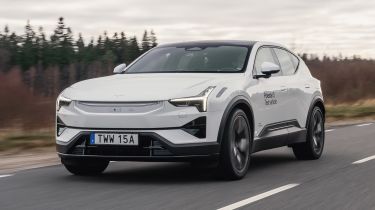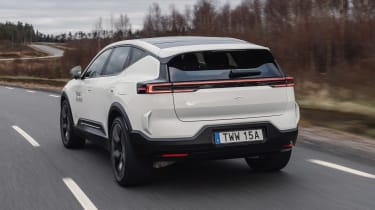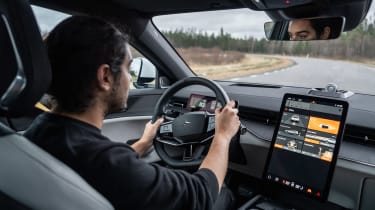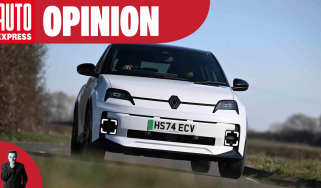New Polestar 3 prototype review: big price, but plenty of promise
Polestar’s big SUV will come with big expectations when it finally lands next year
Verdict
Early signs for the Polestar 3 are very promising. This might be a big and heavy SUV, but thanks to extensive development its driving experience already feels brilliantly executed with only a small caveat in terms of ride quality in the UK. Together with a spacious and luxurious interior, Polestar looks to have created a very desirable new entry into the crowded segment.
The new Polestar 3 SUV will enter a tough segment when it reaches customers next year, facing up to top-spec versions of the Porsche Macan EV, as well as Audi’s Q6 e-tron. But based on an early taste of the Chinese-owned brand’s creation, the 3 might just have the goods to back up its lofty ambitions.
Inherently, the Polestar 3 is based on the same technical base as the forthcoming Volvo EX90, but features a far more dynamic and driver-oriented approach in everything from its sleek, hi-tech design, to the overarching driving experience.
We’ve driven the Long Range and Long Range Performance Pack models, both sharing the same dual-motor set-up with 483bhp or 510bhp respectively, drawing power from a 111kWh battery pack and a 400-volt electrical system. Polestar quotes a range of up to 379 miles on the Long Range model, backed up by 250kW DC fast charging. Lower-specification models will join the range in time.
Used - available now

2025 Polestar
3
1,170 milesAutomaticElectric
Cash £55,999Performance from either variant is more than strictly required for an SUV of this type, but more impressive than its turn of speed is a very good first impression of the handling balance and driver engagement. Despite being a heavy beast (around 2.6 tonnes), the Polestar 3 exhibits superb body control and steering feel, feeling both locked down and trustworthy over the challenging road surfaces within the brand’s test facility.
Speaking to Polestar’s lead chassis engineer Joakim Rydholm while at the wheel, he told us “the three main elements that allowed [me] to do my job are torque-vectoring on the rear axle, air suspension and adaptive dampers.”
We initially jump into the passenger seat, and as a keen rally driver on his days off, Joakim soon has the tail gently oversteering on fast sweeping corners thanks to that power torque vectoring on the rear axle. The 3 has an almost baffling amount of grip considering the slick tarmac, and while this isn’t at all relevant for future customers, it does reiterate the sort of extremes Joakim and his team have gone to in creating a fundamentally capable chassis – something that’s not a given even in this part of the electric SUV market.
Yet while there has been some adoption of high-end chassis hardware, there’s no active anti-roll or rear-wheel steering systems as you find on some rivals, and the Polestar 3 feels all the better for it. “My priority was to make a car that feels natural”, Joakim says. “If I wanted them I would have used them. Sometimes, they can just be a box-ticking exercise.”
Now sitting behind the wheel, we’re inclined to agree. The car has no trouble making exceedingly rapid progress along the narrow and twisty roads with an impressive level of composure. The air suspension does a fantastic job of keeping the body stable, recovering from large undulations with precision, while the adaptive dampers maintain complete control of the 22-inch wheels.
Another key dynamic element of the 3 is its bespoke Pirelli rubber, which was designed and signed off by Joakim and his team. “This was absolutely critical to getting the feel right,” he told us. “The apex of the [tyre] shoulder is so important to steering feel. But we were also given the chance to precisely tailor everything from the compound, tread, sidewall thickness. It’s all developed specifically for this car, working together with the suspension and steering hardware.”
We’ll have to wait until we have the car in the UK to ensure the firm ride doesn’t jar with our rough roads, but to Polestar’s future customers who are coming out of Porsches and BMWs, it won’t feel out of place. There was also some wind noise entering the cabin on test, but the pre-production status of our test cars and incredibly windy conditions might also put this concern to rest.
But more impressive than the driving experience is the driving environment. This is a large car, at 4.9 metres long, but even so, the space inside is exceptional for the class, coming with a high-tech but still luxurious feel. As well as the usual leather and timber materials that will appeal to more traditional markets – albeit in a more contemporary range of colours – Polestar’s approach to challenging the norms of materials and textures is on full display. The vegan leather option, for example, doesn’t use any faux grain, instead featuring a more technical texture. Crucially, though, the material still feels soft and luxurious.
The tech approach shows welcome restraint, with a portrait-oriented 14.5-inch screen on the dash and a small driver’s info display behind the wheel. Both are razor sharp in terms of the interface and graphics, even on this pre-production prototype. While there are few physical controls, there is a play-pause-volume control on the centre console. Most other functions are controlled through the digital interfaces that Polestar says have been tailored to be used on the move.
We found the system to be generally very good, but the sort that like to fidget in their seats and constantly tweak elements like the mirrors still need to dig through a few menus to access them on the move. For everyone else, the system is reliant on personal user profiles that will automatically adjust many of the elements, including most active safety functions, to preset positions. For the ADAS controls that are legally required to be activated upon start-up, there’s a dedicated control on the home screen.
We’ll have to wait to drive it in the UK to know for sure whether the Polestar 3’s talent runs as deep as we think it might, but on initial evidence the company’s third chapter is already shaping up to be a very good one indeed.
| Model: | Polestar 3 Long Range |
| Price: | £79,900 |
| Engine: | 111kWh battery, 2x e-motor |
| Power: | 483bhp/840Nm |
| Transmission: | Single-speed automatic, all-wheel drive |
| 0-62mph: | 4.9 seconds |
| Top speed: | 130mph |
| Range: | 379 miles (WLTP) |
| Charging: | 250kW (10-80% 30 mins) |
| On sale: | Q2 2024 |






